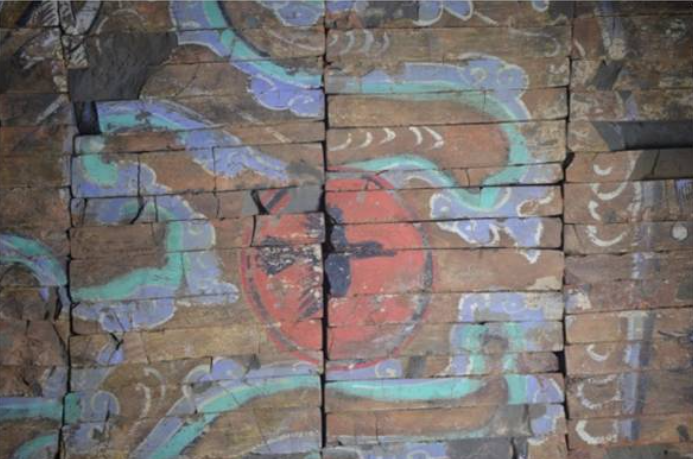史謹《月蝕》“Lunar Eclipse” by Shi Jin (fl. 14th century)
- Rachelle

- Nov 14, 2022
- 3 min read
出海銀蟾一鑑圓,
天狼俄擾失嬋娟。
耳交鐘鼓心尤切,
輪缺山河影漸偏。
玉兔無聲閒杵臼,
素娥潛迹渺雲烟。
掃除喜遇飛亷至,
依舊清光萬古懸。[1]
Out of the sea emerges the silver toad[2] on a mirrored plate,
Clanging and drumming[5] criss-cross in my ears, my heart is much disturbed;
Mountains and rivers wane on the orb, the shadow leans slowly over.
The Jade Hare mutes its sound, resting its mortar and pestle,[6]
The Pure Beauty[7] hides her traces, vanishing into clouds and mists.
Sweeping it all away the God of the Wind is welcomed with joy:
The clear light as ever hangs high for all time.
* From Shi Jin, Duzuiting ji 獨醉亭集 (Wenyuange yingyin Siku quanshu 文淵閣景印四庫全書 vol. 1233, Shanghai: Shanghai guji chubanshe, 1987), 2.31b: https://ctext.org/library.pl?if=en&file=208116&page=110.
[1] In Chinese iconography, the moon is often depicted as a round plate with a toad and the sun with a crow. [2] Chinese mythology offers several theories about eclipses, many of them related to animals. The moon may be swallowed by a celestial dog, a celestial wolf, or an evil toad (presumably the one residing on the moon). [3] Chanjuan 嬋娟 (the lissome one) is a metaphor for the moon. [4] It was believed that one should rescue the sun and the moon during eclipses, typically by making loud noises with bells and drums to scare away the animal that devours the sun or the moon. The rescue was not just an effort of common people but also a regularised ritual that continued to be performed at the court until the early twentieth century. [5] In another folktale, there is a hare on the moon, pounding the elixir of immortality unceasingly in a mortar. [6] Sue 素娥 (Pure Beauty) refers to Chang’e 嫦娥, the goddess of the moon. It is said that she was the wife of Houyi 后羿, a hero of antiquity who saved the world from the scorching heat of ten suns by shooting down nine of them. Chang’e sneaked away the elixir that had been given to Houyi as a reward and flew up to the moon alone, forever separated from her husband. [7] Red characters rhyme.

The sun (right, with a crow in the middle) and the moon (left, with a toad sitting on the crescent) in the T-shaped painting on silk from Mawangdui Tomb No. 1, Western Han period (206 BCE – 9 CE); Hunan Provincial Museum
The sun and the moon depicted in the mural of a Western Han tomb excavated at Xi'an Jiaotong University; screenshot from the VR reproduction of the tomb chamber at http://wszg.xjtu.edu.cn/tour/tour.html

Rubbing of a Western Han relief depicting Chang'e flying to the moon, from Nanyang, Henan; image no. 178 in Chang Renxia 常任俠 ed., Zhongguo meishu quanji huihua bian 中國美術全集·繪畫編 (Shanghai: Shanghai renmin chubanshe, 1988), vol. 18, 146.

Detail of the hanging scroll "Chang'e benyue tu" 嫦娥奔月圖 (Chang'e flying to the moon) by Tang Yin 唐寅 (1470-1524)
Picture credit: National Palace Museum, Taipei
Copyright Declaration*:
The texts and images used on the website of Rachelle's Lab are either from the public domain (e.g. Wikipedia), databases with open data licenses (e.g. Shuhua diancang ziliao jiansuo xitong 書畫典藏資料檢索系統, National Palace Museum, Taipei), online libraries that permit reasonable use (e.g. ctext.org), or original work created for this website.
Although fair use of the website for private non-profit purposes is permitted, please note that the website of Rachelle's Lab and its content (including but not limited to translations, blog posts, images, videos, etc.) are protected under international copyright law. If you want to republish, distribute, or make derivative work based on the website content, please contact me, the copyright owner, to get written permission first and make sure to link to the corresponding page when you use it.
版權聲明:
本站所使用的圖片,皆出自公有領域(如維基)、開放數據庫(如臺北故宮博物院書畫典藏資料檢索系統)、允許合理引用的在線圖書館(如中國哲學電子化計劃)及本人創作。本站允許對網站內容進行個人的、非營利性質的合理使用。但請注意,本站及其內容(包括但不限於翻譯、博文、圖像、視頻等)受國際版權法保護。如需基於博客內容進行出版、傳播、製作衍生作品等,請務必先徵求作者(本人)書面許可,并在使用時附上本站鏈接,註明出處。
*Read more about copyright and permission here.








Comments